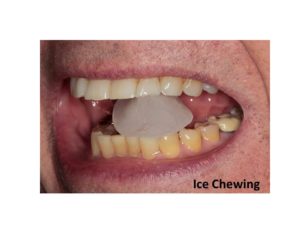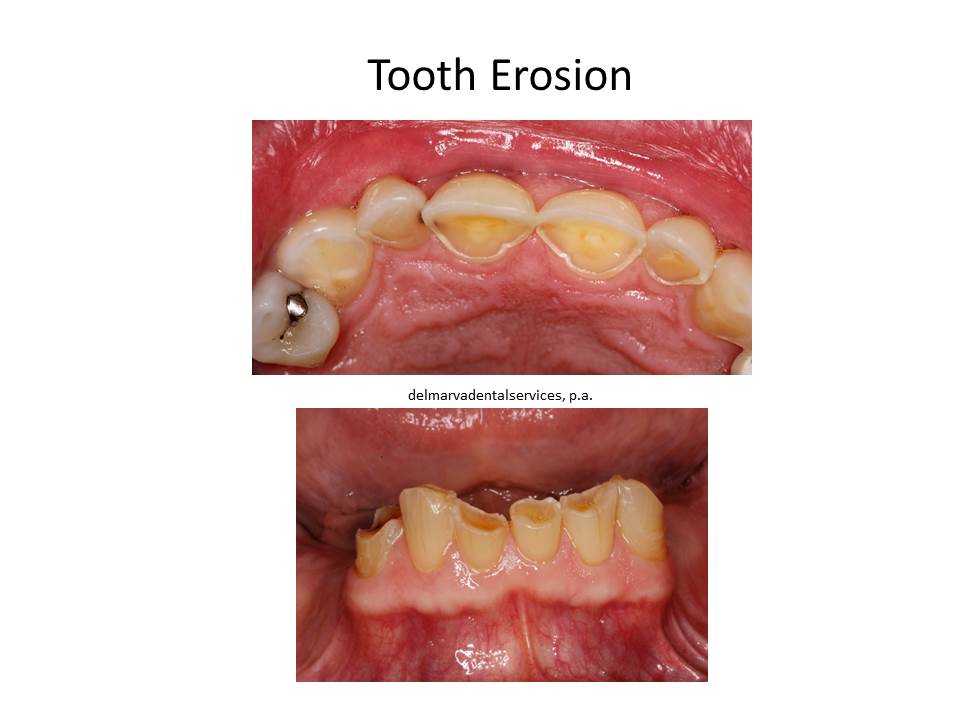Fingernail Biting
It is easy for us to tell fingernail biters at Delmarva Dental Services by looking at their teeth. The lower four front teeth are usually uniformly worn along the edges but only the upper two front teeth show wear. The damage caused by this habit is twofold. Excessive bending of the teeth (yes, teeth bend) causes microcracks in the enamel. These microcracks absorb stains, leading to discolored teeth, and over time the teeth can wear and begin to chip. We have found throughout the years at Delmarva Dental Services, that fingernail and tooth grinding are major reasons for cosmetic dentistry, especially porcelain veneers.
Ice

Believe it or not, using ice is only second to sugar in creating the need for dental treatment. Chewing ice creates not only abnormally high forces on teeth but concentrates it in very small areas. Teeth with large metal amalgam fillings develop cracks and many times create or eventually lead to cracked tooth syndrome. Most cracked teeth need will either need dental crowns, a root canal, or extraction. Alternating from cold to hot during eating and drinking will cause expansion and contraction cracks. An example would be eating hot soup and drinking cold soda with ice. Americans have more of these types of cracks than Europeans due to America’s love of iced drinks. At Delmarva Dental Services the magnification of our intraoral cameras allow us to see these very fine cracks before our patients do. The cracks on front teeth usually don’t lead to cracked tooth syndrome; however, they will absorb stains, causing discolored lines and the gradual darkening of the teeth. We have offered tooth whitening services since 1989 and the majority of patients requesting this service have overused ice. So think twice before you use ice.
Tooth Grinding
The grinding and gnashing of teeth has been recorded as far back as 3500 B.C. The Sumerians thought grinding your teeth was a sign of poor health or even impending death. One remedy included putting a human skull on a chair for three days, adding sacrifices to it each morning and night. It is estimated that 30 percent of the population habitually grind their teeth.
There are two types of grinding. Clenching, which is forcefully pressing the upper and lower teeth together, and bruxing, which is sliding the lower teeth across the upper teeth repeatedly. These habits can be conscious or unconscious. It is usually done during sleeping and can sometimes be heard by others. Signs of clenching and bruxing are sore jaw muscles or jaw joints, headaches, migraines, loose teeth, wear patterns, and frequent tooth fractures. Wear patterns can usually be detected by a dentist. Everyone occasionally clenches when they are angry or lifting a heavy object. However, habitual clenching and bruxing can have serious consequences.
Some clinicians believe that clenching and bruxing are caused by an abnormal bite. This occurs when teeth hit unevenly or interfere during various jaw movements. The theory is that the body is trying to grind away portions of tooth that interfere. In prehistoric times the coarse diet wore away these areas, but our modern diet fails to provide this service. Other theories are that clenching and bruxing are caused by stress, hormonal changes, or vitamin/mineral deficiencies. Lastly, some dental clinicians believe that it is caused by airway restriction. The body attempts to increase air intake through the processes of bruxing and snoring. There are many environmental factors that cause airway restriction such as swollen tonsils or adenoids, nasal obstruction, and allergies.The average biting force of a human is about 200 to 300 pounds per square inch (psi). It takes 28psi to chew a carrot. Most people bite for about 30 minutes a day with a biting force of 30 psi. Clenchers and bruxers have over developed jaw muscles and can generate 500 to 900psi over a period of hours. These kinds of forces can cause tooth wear, tooth cracking, filling fracture, loose teeth, earaches, headaches, and migraines. The best treatment is using preventive measures before any damage can occur. Preventive treatment for bruxism can involve bite guards, braces, bite adjustments, stress reduction, and medication. Acute pain can be treated with BOTOX® injections to relieve the pain, and any damage to the teeth needs to be restored.
Dissolving Our Teeth

There is an epidemic of dissolving teeth in the U.S. and most everyone is anywhere. Because it is slow like the erosion of the seashore by waves or the wind erosion of giant rocks in the desert. It is all about acid and what acid does. Acids dissolve stuff. As if it weren’t bad enough that we get cavities from the acids bacteria make after eating sugar, now we’ve gone and made it worse. We are causing our tooth structure to erode by drinking too many acid containing drinks. Fourteen percent of schoolchildren ages 5 to 9 years have erosion in their permanent teeth and 43 percent of adolescents.
So what is the culprit? Soft drinks, sports drinks, energy drinks, fruit juice and even wine if ingested frequently enough will cause tooth erosion. Our serving size in America of flavored drinks has increased from 7 ounces in the fifties, to 12 ounces in the sixties, to 20 ounces in the late 90’s. So the quantity is greater. But that is not the main problem. The two primary causes are the amount of acid in the drinks has increased and the frequency of consumption has increased. Phosphoric and citric acid are added to most all of these drinks. The drinks with the highest amount are energy drinks like Red Bull, Rockstar, Monster, and 5 Hour Energy. These energy drinks should be avoided entirely because they are 2 to 5 times more acidic than soft drinks and sports drinks like Gatorade. So you think you’re in the clear with fruit juice? Not so fast fruit juices are more acidic than soft drinks. The most important factor is the frequency you drink acidic drinks. Sipping over a period of an hour or more is much more erosive than drinking a drink in 15 minutes. That is because when acid drinks or foods enter your mouth your saliva will slowly neutralize the acid over the next hour. Constantly sipping never gives your saliva a chance to neutralize the acid. And swishing the liquid back and forth between your cheeks is the worst because you are acid washing your teeth repeatedly. So what can you do? No energy drinks, no sipping, no swishing. Drink water after we consume an acid containing drink. Never brush your teeth right after an acid drink or food because it increases the erosion. Wait an hour before you brush. Use a low abrasive high fluoride toothpaste like Sensodyne ProNamel. This is important because it puts a coating on your teeth which makes it more acid resistant to erosion and cavities. * When acidity is referred to, it means titratable acidity not ph. Titratable acidity is the amount of a liquid (usually Sodium Hydroxide) it takes to neutralize an acid.
